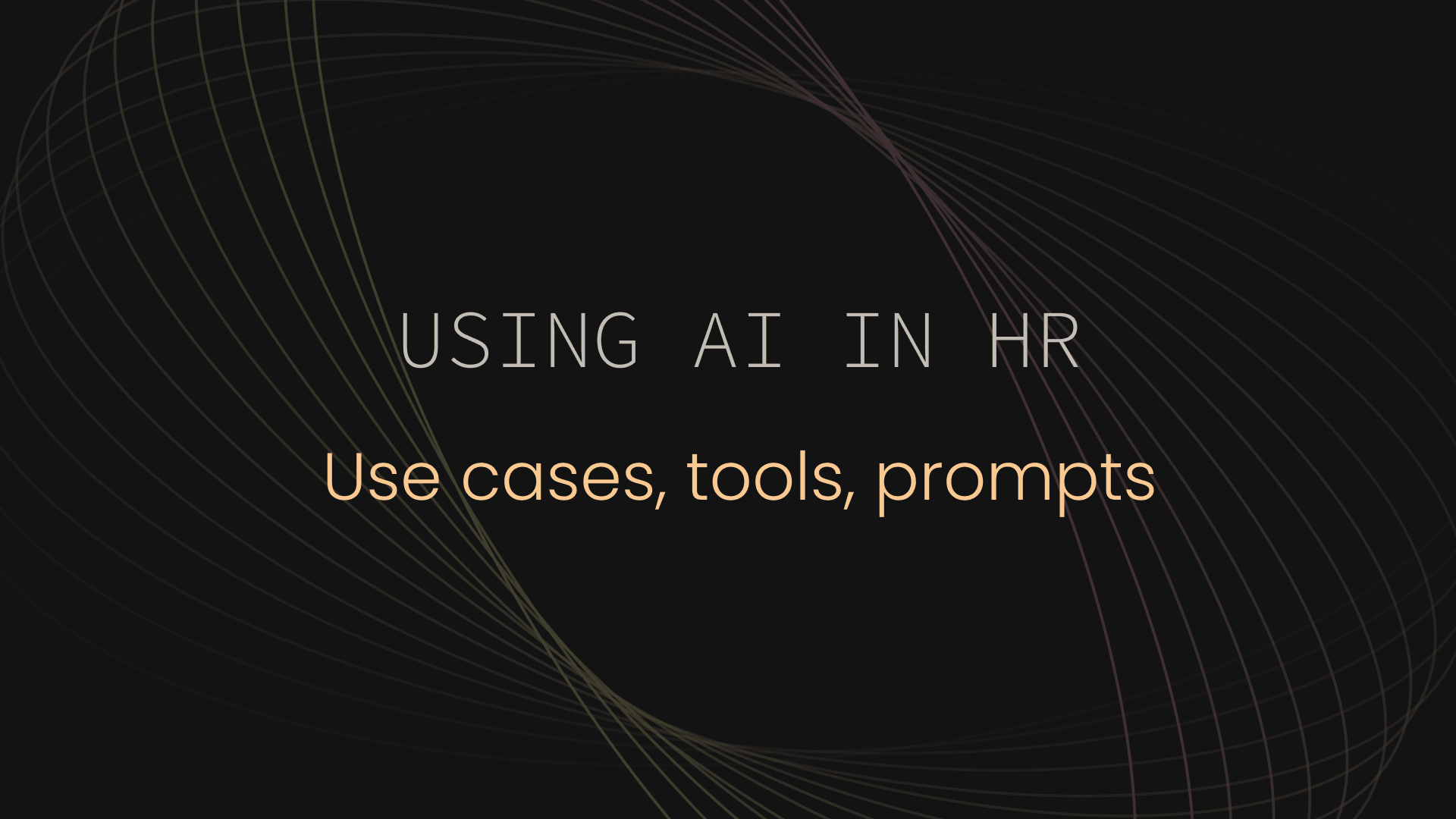Insights
3.10.2025
Miikka Kataja
How can AI be used in HR and people functions?
A practical guide to the main use cases of AI in HR, with real-world tools and examples to get started.

AI is no longer futuristic, it’s already woven into HR. According to SHRM, 43% of organizations now leverage AI in HR tasks, up from 26% just a year earlier (shrm.org). Yet many HR teams are still figuring out how best to apply it. In 2025, AI offers opportunities across performance, operations, learning, and recruiting, if deployed thoughtfully.
In this article, we’ll explore the key AI use cases across HR functions and showcase tools and workflows that are already helping HR teams scale people operations.
"43% of organizations now leverage AI in HR tasks"
1. How to use AI in performance management
Performance management is undergoing a fundamental shift. Instead of relying on annual reviews, AI tools enable real-time performance insights, continuous coaching, and role-based expectations. This makes the process less about backward evaluation and more about forward-looking growth.
Use case: Real-time feedback, goal alignment, micro coaching
- Role-based expectation generation
- Automated prompts & nudges
- Coaching suggestions
- Trend detection
Example tools:
- Taito.ai — automates goal suggestions, feedback cycles, and coaching nudge generation
- Lattice — uses analytics and AI to highlight potential performance issues or patterns
- Culture Amp — adds AI overlays to engagement and performance data to spot risk areas
2. How to apply AI in core HR operations & HRIS
Behind every HR function is a system of record. AI-powered HRIS platforms are transforming from simple databases into predictive engines that automate workflows, flag risks, and give leaders actionable insights. This evolution helps HR teams move from reactive administration to proactive strategy.
Use case: Automating workflows, surfacing insights, predictive HR analytics
Example tools:
- DreamTeam.io — AI-centric HRIS for scaling teams
- HiBob — combines people data with engagement and planning analytics
- Humaans — streamlines onboarding and compliance
3. How to use AI in learning & development
The L&D function has seen some of the most creative AI applications. With adaptive learning systems and generative content, organizations can deliver highly personalized training at scale. Instead of long, generic courses, employees now receive just-in-time learning that matches their goals and skills.
Use case: Personalized, scalable, content generation & delivery
Example tools:
- Sana Labs (Workday) — adaptive learning powered by AI
- Synthesia — creates training videos with avatars and voiceovers in minutes
- CourseBox AI — automates course generation from documents
4. What are best uses for AI in talent acquisition & recruiting
Recruiting has become one of the most AI-driven areas in HR. With massive candidate pools and high expectations for speed, AI helps recruiters find better matches, reduce bias, and save time. From smart sourcing to video interview analysis, AI is now embedded at every stage of the hiring funnel.
Use case: Sourcing, screening, interviewing with AI assistance
Example tools:
- Peoplebox.ai — aligns recruiting OKRs with pipelines
- Workable — AI for sourcing, screening, job ad optimization
- HireVue — structured video interviews with AI scoring
5. How to leverage ChatGPT and other LLM tools in HR
Beyond specialized platforms, HR teams can also leverage LLMs like ChatGPT for quick wins across multiple functions. While not replacements for core HR systems, LLMs are excellent for drafting, ideation, and rapid research.
Sample HR Prompts:
- Performance Management:
“Draft a role expectation framework for a mid-level product manager, including deliverables and skills.” - HRIS Operations:
“Create a checklist for onboarding a new hire, covering compliance, IT, and manager steps.” - Learning & Development:
“Generate a training module outline on giving constructive feedback, including exercises and examples.” - Recruiting:
“Write five unbiased interview questions to assess collaboration skills for a sales role.”
While tools like Taito.ai or Workable automate end-to-end workflows, LLMs like ChatGPT remain flexible assistants—ideal for content creation, brainstorming, and prototyping HR processes.
6. Word about integration, ethics, and AI maturity
While the potential is clear, AI in HR is still at an early maturity stage. Many organizations are experimenting with tools, but few have achieved seamless integration across HR functions. Ethical use, transparency, and employee trust remain critical challenges.
"Almost all companies invest in AI, but just 1% believe they are at maturity."
McKinsey notes that “almost all companies invest in AI, but just 1% believe they are at maturity” (mckinsey.com). That suggests adoption is high, but transformation is still early.
What to consider when implementing AI for HR
AI is no longer just a future trend, it’s already transforming HR across performance management, HRIS, learning, and recruiting. From continuous performance enablement with tools like Taito.ai, to personalized training with Synthesia, to smarter recruiting with Workable and HireVue, AI is enabling HR teams to work faster, fairer, and more strategically. Large language models like ChatGPT add flexibility, helping HR leaders draft frameworks, training modules, and interview questions on demand.
The next step for HR teams is to start small: pilot one use case, measure impact, and expand from there. Whether you begin with recruiting automation, AI-driven performance frameworks, or adaptive learning, each step builds maturity and confidence in using AI responsibly. Done well, AI becomes not just a tool, but a partner in building a more engaged, empowered, and future-ready workforce.
FAQ
Q1: Can AI replace HR professionals?
No. AI augments HR, automating repetitive tasks so people leaders can focus on coaching, culture, and strategy.
Q2: Which HR function benefits most from AI first?
Recruiting and screening show early ROI, but performance and L&D benefit significantly once integrated.
Q3: What are the risks of using AI in HR?
Bias, transparency gaps, data privacy, and overreliance on algorithms. Mitigation requires human oversight and ethical guardrails.
Q4: How can HR teams begin with AI?
Start with a single pilot (e.g. resume screening or feedback prompts), measure impact, and scale with trust and training.